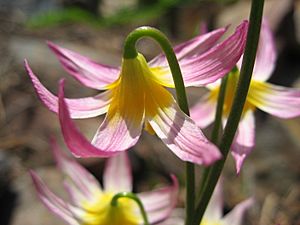Purple fawn lily facts for kids
Quick facts for kids Purple fawn lily |
|
|---|---|
 |
|
| Scientific classification | |
| Genus: |
Erythronium
|
| Species: |
purpurascens
|
| Synonyms | |
|
Synonymy
Erythronium grandiflorum var. multiflorum Torr.
Erythronium revolutum Baker 1876, illegitimate homonym not Sm. 1809 Erythronium purpurascens var. uniflorum S.Watson Erythronium grandiflorum f. multiflorum (Torr.) Voss |
|
Erythronium purpurascens is a beautiful flowering plant. It belongs to the lily family. People often call it the purple fawn lily or the Sierra Nevada fawn lily.
This special plant grows only in California. It is endemic to this state, meaning it's found nowhere else naturally. You can find it high up in the mountains. It lives in places like the southern Cascade Range, the Coast Ranges, and the northern Sierra Nevada. It grows from Siskiyou County all the way down to Mendocino and Placer Counties.
Contents
About the Purple Fawn Lily
This mountain wildflower, Erythronium purpurascens, starts its life from a bulb. A bulb is like a small, underground storage unit for the plant. Its bulb is usually 2 to 4 centimeters long.
Leaves and Stems
The plant grows two long, narrow green leaves. These leaves can be up to 15 centimeters in length. It also has strong, upright stalks. These stalks can grow up to 20 centimeters tall. Each stalk can hold one to six flowers.
Flowers and Colors
The flowers of the purple fawn lily are very interesting. They have white tepals. Tepals are like petals and sepals combined. The bases of these tepals are yellow. As the flowers get older, their white parts slowly turn purple. Each tepal is about one or two centimeters long. They also curl back, giving the flower a unique look.
Flower Parts
Inside the flower, you'll see the stamens. These are the male parts of the flower. They have large, yellow anthers, which hold the pollen. The style is the female part of the flower. It is also yellow.
When It Blooms
The purple fawn lily blooms when the last of the snow melts. This can be quite late in the year. At very high elevations, it might not bloom until summer.
See also
 In Spanish: Erythronium purpurascens para niños
In Spanish: Erythronium purpurascens para niños

